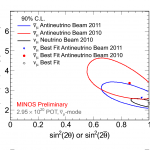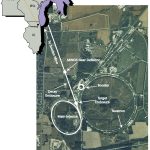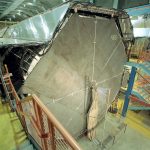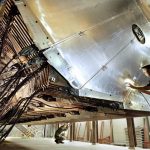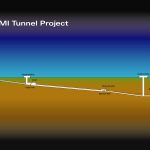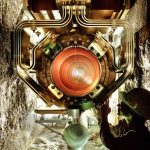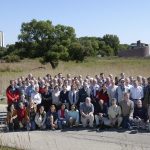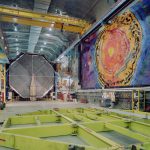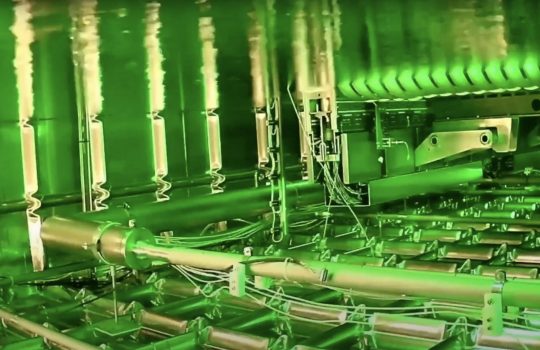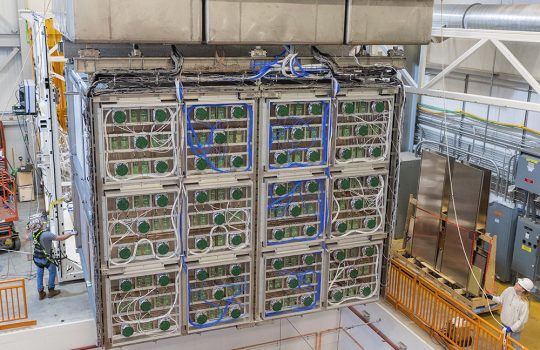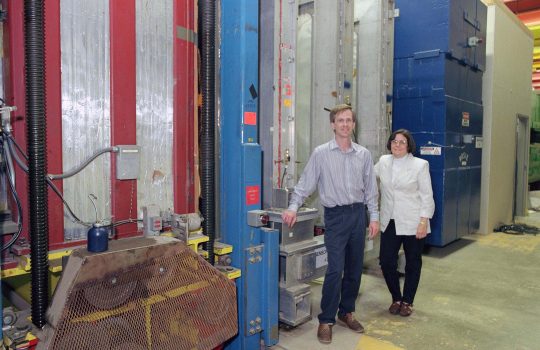BATAVIA, Illinois — The physics community got a jolt last year when results showed for the first time that neutrinos and their antimatter counterparts, antineutrinos, might be the odd man out in the particle world and have different masses. This idea was something that went against most commonly accepted theories of how the subatomic world works.
A result released today (August 25) from the MINOS experiment at the Department of Energy’s Fermi National Accelerator Laboratory appears to quell concerns raised by a MINOS result in June 2010 and brings neutrino and antineutrino masses more closely in sync.
By bringing measurements of neutrinos and antineutrinos closer together, this new MINOS result allows physicists to lessen the potential ramifications of this specific neutrino imbalance. These ramifications include: a new way neutrinos interact with other particles, unseen interactions between neutrinos and matter in the earth and the need to rethink everything known about how the universe works at the tiniest levels.
“This more precise measurement shows us that these particles and their antimatter partners are very likely not as different as indicated earlier. Within our current range of vision it now seems more likely that the universe is behaving the way most people think it does,” said Rob Plunkett, Fermilab scientist and co-spokesman of MINOS. “This new, additional information on antineutrino parameters helps put limits on new physics, which will continue to be searched for by future planned experiments.”
University College London Physics Professor and MINOS co-spokesperson Jenny Thomas presented this new result — the world’s best measurement of muon neutrino and antineutrino mass comparisons — at the International Symposium on Lepton Photon Interactions at High Energies in Mumbai, India.
MINOS nearly doubled its data set since its June 2010 result from 100 antineutrino events to 197 events. While the new results are only about one standard deviation away from the previous results, the combination rules out concerns that the previous results could have been caused by detector or calculation errors. Instead, the combined results point to a statistical fluctuation that has lessened as more data is taken.
Physicists measured the differences between the squared masses between two types of neutrinos and compared them to the squared masses between two types of antineutrinos, a quantity called delta m squared. The 2010 result found, as a whole, that the range of mass difference in the neutrinos was about 40 percent less for antineutrinos, while the new result found a 16 percent difference.
“The previous results left a 2 percent chance that the neutrino and antineutrino masses were the same. This disagrees with what theories of how neutrinos operate predicted,” Thomas said. “So we have spent almost a year looking for some instrumental effect that could have caused the difference. It is comforting to know that statistics were the culprit.”
Because several neutrino experiments operating and planned across the globe rely on neutrino and antineutrino measurements being the same as part of their calculations, the new MINOS result hopefully removes a potential hurdle for them.
Fermilab’s accelerator complex is capable of producing intense beams of either muon antineutrinos or muon neutrinos to send to the two MINOS detectors, one at Fermilab and one in Minnesota. This capability allows the experimenters to measure the mass difference parameters. The measurement also relies on the unique characteristics of the MINOS far detector, particularly its magnetic field, which allows the detector to separate the positively and negatively charged muons resulting from interactions of antineutrinos and neutrinos, respectively.
The antineutrinos’ extremely rare interactions with matter allow most of them to pass through the Earth unperturbed. A small number, however, interact in the MINOS detector, located 735 km away from Fermilab in Soudan, Minnesota. During their journey, which lasts 2.5 milliseconds, the particles oscillate in a process governed by a difference between their mass states.
Further analysis will be needed by the upcoming Fermilab neutrino experiments NOvA and MINOS+ to close the mass difference even more. Both experiments will use an upgraded accelerator beam generated at Fermilab that will emit more than double the number of neutrinos. This upgraded beam is expected to start operating in 2013.
The MINOS experiment involves more than 140 scientists, engineers, technical specialists and students from 30 institutions, including universities and national laboratories, in five countries: Brazil, Greece, Poland, the United Kingdom and the United States. Funding comes from: the Department of Energy’s Office of Science and the National Science Foundation in the U.S., the Science and Technology Facilities Council in the U.K; the University of Minnesota in the U.S.; the University of Athens in Greece; and Brazil’s Foundation for Research Support of the State of São Paulo (FAPESP) and National Council of Scientific and Technological Development (CNPq).
Fermilab is a national laboratory supported by the Office of Science of the U.S. Department of Energy, operated under contract by Fermi Research Alliance, LLC.
The DOE Office of Science is the single largest supporter of basic research in the physical sciences in the United States, and is working to address some of the most pressing challenges of our time. For more information, please visit http://science.energy.gov.
- Scientists know that there exist three types of neutrinos and three types of antineutrinos. Cosmological observations and laboratory-based experiments indicate that the masses of these particles must be extremely small: Each neutrino and antineutrino must weigh less than a millionth of the weight of an electron.
- This graph demonstrates that the new MINOS antineutrino result (blue) is more precise than last year’s result (red), as reflected by the smaller oval, and the new result is in better agreement with the mass range of the 2010 neutrino result (black), reflected by the overlap of the blue and red ovals. The ovals represent the 90 percent statistical confidence levels for each result. A 90 percent confidence level means that if scientists were to repeat the measurement many times, they would expect to obtain a result that lies within the contour 90 percent of the time. The points inside the ovals show the best, or most likely, value for each of the three measurements. The best value for the 2011 measurement of the squared mass difference for the antineutrinos is 2.62 x 10-3 eV2.
- Neutrinos, ghost-like particles that rarely interact with matter, travel 450 miles straight through the earth from Fermilab to Soudan — no tunnel needed. The Main Injector Neutrino Oscillation Search (MINOS) experiment studies the neutrino beam using two detectors. The MINOS near detector, located at Fermilab, records the composition of the neutrino beam as it leaves the Fermilab site. The MINOS far detector, located in Minnesota, half a mile underground, again analyzes the neutrino beam. This allows scientists to directly study the oscillation of muon neutrinos into electron neutrinos or tau neutrinos under laboratory conditions.
- The MINOS far detector is located in a cavern half a mile underground in the Soudan Underground Laboratory, Minnesota. The 100-foot-long MINOS far detector consists of 486 massive octagonal planes, lined up like the slices of a loaf of bread. Each plane consists of a sheet of steel about 25 feet high and one inch thick, with the last one visible in the photo. The whole detector weighs 6,000 tons. Since March 2005, the far detector has recorded neutrinos from a beam produced at Fermilab. The MINOS collaboration records about 1,000 neutrinos per year.
- The 1,000-ton MINOS near detector sits 350 feet underground at Fermilab. The detector consists of 282 octagonal-shaped detector planes, each weighing more than a pickup truck. Scientists use the near detector to verify the intensity and purity of the muon neutrino beam leaving the Fermilab site. Photo: Peter Ginter
- Fermilab completed the construction and testing of the Neutrino at the Main Injector (NuMI) beam line in early 2005. Protons from Fermilab’s Main Injector accelerator (left) travel 1,000 feet down the beam line, smash into a graphite target and create muon neutrinos. The neutrinos traverse the MINOS near detector, located at the far end of the NuMI complex, and travel straight through the earth to a former iron mine in Soudan, Minnesota, where they cross the MINOS far detector. Some of the neutrinos arrive as electron neutrinos or tau neutrinos.
- When operating at highest intensity, the NuMI beam line transports a package of 35,000 billion protons every two seconds to a graphite target. The target converts the protons into bursts of particles with exotic names such as kaons and pions. Like a beam of light emerging from a flashlight, the particles form a wide cone when leaving the target. A set of two special lenses, called horns (photo), is the key instrument to focus the beam and send it in the right direction. The beam particles decay and produce muon neutrinos, which travel in the same direction. Photo: Peter Ginter
- More than 140 scientists, engineers, technical specialists and students from Brazil, Greece, Poland, the United Kingdom and the United States are involved in the MINOS experiment. This photo shows some of them posing for a group photo at Fermilab, with the 16-story Wilson Hall and the spiral-shaped MINOS service building in the background.
- Far view The University of Minnesota Foundation commissioned a mural for the MINOS cavern at the Soudan Underground Laboratory, painted onto the rock wall, 59 feet wide by 25 feet high. The mural contains images of scientists such as Enrico Fermi and Wolfgang Pauli, Wilson Hall at Fermilab, George Shultz, a key figure in the history of Minnesota mining, and some surprises. A description of the mural, painted by Minneapolis artist Joe Giannetti, is available here.


